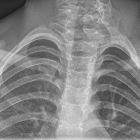omovertebral bone




Mutation in
MEOX1gene causes a recessive Klippel-Feil syndrome subtype. Patient photographs of family members IV-2 and IV-3 show KFS phenotypes. Photographs of patients from the side (A and B) and behind (C and D) show short neck, low posterior hairline, and elevated scapula (Sprengel’s deformity). 3D cervical spine skull base CT images show omovertebral bone causing Sprengel’s deformity, posterior neural arch fusion defects, and fusions between vertebrae (E and F). Whole spine sagittal section T2-weighted MR images show cervical vertebrae count anomaly (G and H). Axial skull base CT images show malformation of the foramen magnum (I and J). Sagittal reconstruction of cervical and skull base CT images show abnormal bony formation emerging from posterior structures as well as fusion between posterior structures of some successive vertebrae, occipitalization of atlas and dens, and corpus anomalies (K and L). Scoliosis is evident on coronal T2-weighted whole spine MR images. Fusion defects are seen in midportions of vertebra corpuses (M and N).

Omovertebral
bone • Sprengel deformity with os omovertebrale - Ganzer Fall bei Radiopaedia

Omovertebral
bone • Sprengel deformity - Ganzer Fall bei Radiopaedia

Omovertebral
bone • Large omovertebral bone - sprengel shoulder - Ganzer Fall bei Radiopaedia

Omovertebral
bone • Sprengel deformity - Ganzer Fall bei Radiopaedia

Omovertebral
bone • Omovertebral bone with Sprengel shoulder - Ganzer Fall bei Radiopaedia

Omovertebral
bone • Bilateral Sprengel deformity with Klippel-Feil syndrome - Ganzer Fall bei Radiopaedia

Omovertebral
bone • Sprengel shoulder with omovertebra - Ganzer Fall bei Radiopaedia

Omovertebral
bone • Sprengel deformity - Ganzer Fall bei Radiopaedia
The omovertebral bone (os omovertebrale) is present in ~35% (range 19-47%) of cases of Sprengel deformity.
Gross anatomy
It runs from the superomedial border of the scapula to the spinous processes, transverse processes or laminae of C4 to C7 . Occasionally it can be bilateral . The connection from the scapula to the vertebrae may be fibrous or osseous.
Siehe auch:
und weiter:

 Assoziationen und Differentialdiagnosen zu Os omo-vertebrale:
Assoziationen und Differentialdiagnosen zu Os omo-vertebrale:

